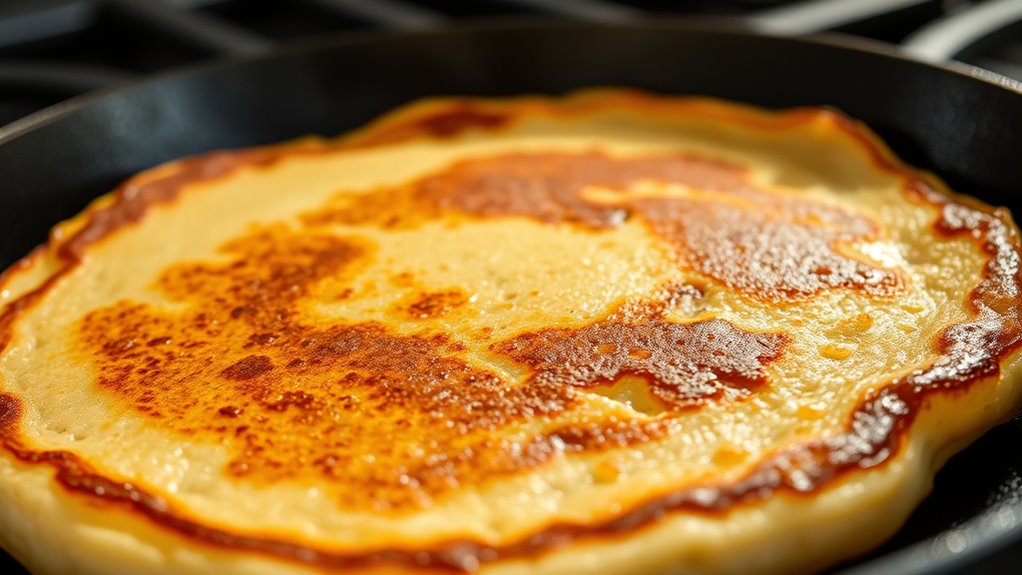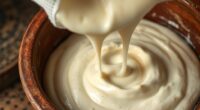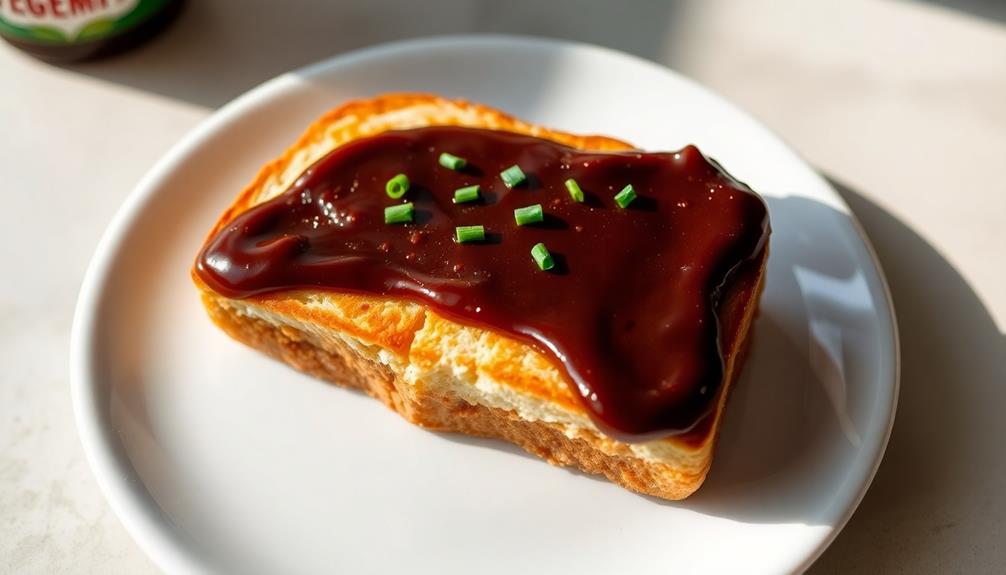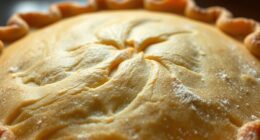Uneven pancake browning happens when heat isn’t transferred evenly from your pan to the batter. Hot spots or inconsistent heat conduction cause some edges to brown faster while others stay pale. Using the wrong pan material or cooking at too high a temperature can create these issues. Keeping your pan well-heated and steady helps distribute heat more evenly. To master perfect pancakes, understanding heat conduction patterns can make all the difference—there’s more to discover if you keep exploring.
Key Takeaways
- Uneven heat distribution in the pan causes certain areas to heat faster, leading to uneven browning.
- Hot spots from poor pan material or uneven preheating create localized areas of excessive heat.
- Too high cooking temperature accelerates browning on the outside before the inside cooks evenly.
- Inconsistent heat conduction results in parts of the pancake browning faster and others remaining pale.
- Using a pan with inadequate heat conduction properties can prevent uniform heat transfer, causing uneven coloring.

When you cook a pancake, heat conduction plays a critical role in determining how evenly it cooks. The way heat moves from the pan into the batter directly influences the pancake’s texture and overall doneness. If heat isn’t distributed uniformly, you’ll notice parts of your pancake browning faster than others, leading to an uneven appearance and inconsistent texture. For a perfectly cooked pancake, understanding how heat conduction interacts with cooking temperature is essential. The key to achieving an evenly browned pancake lies in controlling the cooking temperature. If the heat is too high, the outer edges will crisp and brown rapidly, while the inside remains undercooked or gooey. Conversely, if the temperature is too low, the pancake may cook slowly, resulting in a pale, dull surface and a dense interior. Balancing the right temperature ensures that heat gradually penetrates the batter, promoting a uniform rise and even browning. When the pan’s temperature is just right, heat conduction allows the heat to spread evenly from the hot surface into the pancake, creating a consistent crust and tender interior. Proper heat conduction is also influenced by the material of the pan, which affects how heat is transferred and can help prevent hot spots. The pancake’s texture is heavily influenced by how heat conducts through the batter. Proper heat conduction causes the proteins and starches to set at a uniform rate, which helps achieve the desired fluffy and light texture. If heat is uneven, some parts of the batter may overcook, becoming tough or crispy, while others remain undercooked and soggy. This inconsistency affects the pancake’s overall mouthfeel and appearance. To optimize heat conduction, preheating your pan to a moderate temperature and maintaining it throughout cooking is essential. This steady heat allows the pancake to cook evenly from the outside in, avoiding hot spots that cause uneven browning. Additionally, understanding the importance of heat conduction patterns can help you troubleshoot and improve your pancake cooking technique for consistent results. A well-maintained pan temperature is crucial for consistent heat conduction and perfect pancakes.
Frequently Asked Questions
How Does Pancake Batter Thickness Affect Browning?
Your pancake batter’s thickness directly impacts browning because thicker batter often leads to uneven heat conduction. When batter has inconsistent consistency or thickness, heat doesn’t distribute evenly, causing some areas to brown faster. For uniform browning, aim for a smooth, consistent batter that spreads evenly. This ensures heat flows uniformly through the batter, resulting in evenly browned pancakes and better texture.
Can Altitude Influence Pancake Browning Patterns?
Imagine your pancake batter soaring higher, where the air thins and pressure drops. Altitude effects, like lower air pressure, cause moisture to evaporate faster, affecting heat transfer. This can lead to uneven browning, as heat distributes differently at high altitudes. You might notice your pancakes cook unevenly or brown too quickly on the outside. Adjusting heat and batter thickness helps counter these altitude effects, ensuring more evenly golden pancakes every time.
Does the Type of Pan Material Change Heat Conduction?
Yes, the pan material considerably affects heat conduction and distribution. You’ll notice that metal pans like cast iron or stainless steel heat quickly and evenly, helping your pancakes brown uniformly. Non-stick or ceramic pans may distribute heat differently, leading to uneven browning. By choosing the right pan material, you improve heat transfer, ensuring your pancakes cook evenly and develop a perfect golden crust every time.
How Do Flipping Techniques Impact Uneven Browning?
Your flip technique and flipping timing considerably impact uneven browning. If you flip too early or too late, you risk uneven heat distribution, causing parts of your pancake to brown differently. Use a confident flip technique and wait until bubbles form and edges look set before flipping. This ensures even heat transfer, resulting in a uniformly browned pancake. Proper timing and technique are key to achieving perfect, evenly browned pancakes every time.
What Role Does Sugar Content Play in Browning?
Think of sugar as a tiny conductor of heat, guiding the browning process. Higher sugar content accelerates caramelization, creating a richer color and flavor. As sugar crystallizes, it forms a barrier that can influence heat transfer, leading to uneven browning. So, when you add more sugar, you’re fundamentally inviting a faster caramelization process, which can cause parts of your pancake to brown more quickly than others, affecting its overall appearance.
Conclusion
Understanding heat conduction helps you see why your pancakes brown unevenly. Remember, the side touching the pan gets hotter faster, often by up to 20% more heat than the top. So next time, pay attention to how the pan heats and flip your pancake at the right moment. By controlling heat transfer, you can achieve perfectly golden pancakes every time—making breakfast more delicious and visually appealing!










